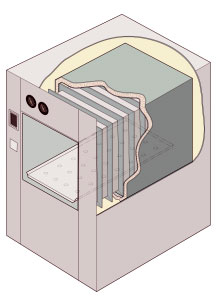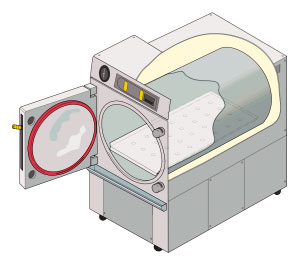Autoclave




Autoclave
An autoclave is a device used to carry out industrial and scientific processes requiring elevated temperature and pressure different from ambient air pressure. Autoclaves are used in applications such as sterilization of medical equipment, chemical reactions, and the curing of composites.
History[edit]
The concept of the autoclave was first developed by Charles Chamberland in 1879. The invention was a significant advancement in the field of microbiology and medicine, allowing for the effective sterilization of surgical instruments and other medical tools.
Principle of Operation[edit]
Autoclaves operate on the principle of steam under pressure. The basic process involves:
- Loading the items to be sterilized into the autoclave chamber.
- Sealing the chamber and removing air from it.
- Introducing steam into the chamber at high pressure.
- Maintaining the temperature and pressure for a specified period.
- Allowing the chamber to cool and depressurize before opening.
Types of Autoclaves[edit]
There are several types of autoclaves, including:
- Gravity displacement autoclaves: These use steam to displace air in the chamber.
- Pre-vacuum autoclaves: These remove air from the chamber using a vacuum pump before introducing steam.
- Steam-flush pressure-pulse autoclaves: These use repeated pulses of steam to remove air from the chamber.
Applications[edit]
Autoclaves are used in various fields, including:
- Medicine: Sterilizing surgical instruments, laboratory equipment, and medical waste.
- Microbiology: Sterilizing culture media and laboratory glassware.
- Dentistry: Sterilizing dental instruments.
- Veterinary medicine: Sterilizing veterinary instruments and equipment.
- Industrial applications: Curing composites, vulcanizing rubber, and processing certain chemicals.
Safety and Maintenance[edit]
Proper maintenance and safety protocols are essential for the safe operation of autoclaves. Regular inspections, calibration, and adherence to manufacturer guidelines help ensure the autoclave operates effectively and safely.
See Also[edit]
References[edit]
<references group="" responsive="1"></references>
External Links[edit]
Ad. Transform your life with W8MD's Budget GLP-1 injections from $75


W8MD offers a medical weight loss program to lose weight in Philadelphia. Our physician-supervised medical weight loss provides:
- Weight loss injections in NYC (generic and brand names):
- Zepbound / Mounjaro, Wegovy / Ozempic, Saxenda
- Most insurances accepted or discounted self-pay rates. We will obtain insurance prior authorizations if needed.
- Generic GLP1 weight loss injections from $75 for the starting dose.
- Also offer prescription weight loss medications including Phentermine, Qsymia, Diethylpropion, Contrave etc.
NYC weight loss doctor appointmentsNYC weight loss doctor appointments
Start your NYC weight loss journey today at our NYC medical weight loss and Philadelphia medical weight loss clinics.
- Call 718-946-5500 to lose weight in NYC or for medical weight loss in Philadelphia 215-676-2334.
- Tags:NYC medical weight loss, Philadelphia lose weight Zepbound NYC, Budget GLP1 weight loss injections, Wegovy Philadelphia, Wegovy NYC, Philadelphia medical weight loss, Brookly weight loss and Wegovy NYC
|
WikiMD's Wellness Encyclopedia |
| Let Food Be Thy Medicine Medicine Thy Food - Hippocrates |
Medical Disclaimer: WikiMD is not a substitute for professional medical advice. The information on WikiMD is provided as an information resource only, may be incorrect, outdated or misleading, and is not to be used or relied on for any diagnostic or treatment purposes. Please consult your health care provider before making any healthcare decisions or for guidance about a specific medical condition. WikiMD expressly disclaims responsibility, and shall have no liability, for any damages, loss, injury, or liability whatsoever suffered as a result of your reliance on the information contained in this site. By visiting this site you agree to the foregoing terms and conditions, which may from time to time be changed or supplemented by WikiMD. If you do not agree to the foregoing terms and conditions, you should not enter or use this site. See full disclaimer.
Credits:Most images are courtesy of Wikimedia commons, and templates, categories Wikipedia, licensed under CC BY SA or similar.
Translate this page: - East Asian
中文,
日本,
한국어,
South Asian
हिन्दी,
தமிழ்,
తెలుగు,
Urdu,
ಕನ್ನಡ,
Southeast Asian
Indonesian,
Vietnamese,
Thai,
မြန်မာဘာသာ,
বাংলা
European
español,
Deutsch,
français,
Greek,
português do Brasil,
polski,
română,
русский,
Nederlands,
norsk,
svenska,
suomi,
Italian
Middle Eastern & African
عربى,
Turkish,
Persian,
Hebrew,
Afrikaans,
isiZulu,
Kiswahili,
Other
Bulgarian,
Hungarian,
Czech,
Swedish,
മലയാളം,
मराठी,
ਪੰਜਾਬੀ,
ગુજરાતી,
Portuguese,
Ukrainian
